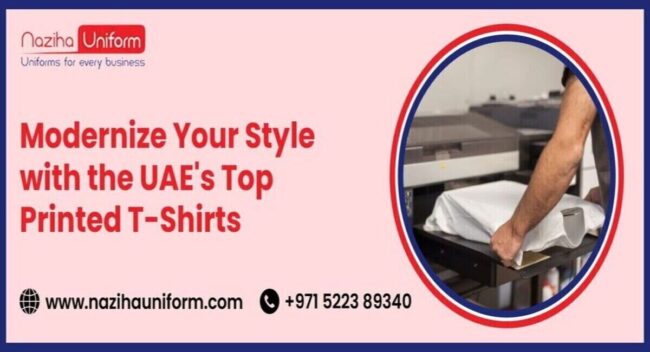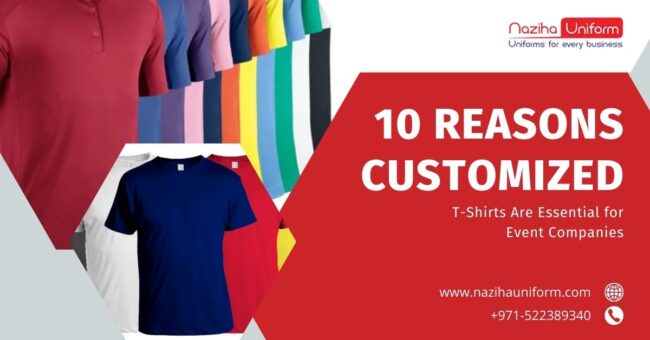Modernize Your Style with the UAE’s Top Printed T-Shirts
In Dubai’s bustling marketplace, where personalization and fashion intersect, finding a reliable printed t-shirt supplier can make all the difference for individual customers and corporations. It’s essential to have access to high-quality t-shirts that represent your vision. Whether you’re looking to promote your brand, celebrate an event, or add a touch of personalization to your wardrobe, having access to quality t-shirts that reflect your vision is essential.
This city, famed for its luxury and ingenuity, is also home to some of the best T-shirt vendors. These vendors redefine casual wear with modern designs and high-quality prints. Here’s how you can modernize your wardrobe with their offerings.
Explore a World of T-Shirt Styles
T-shirt suppliers in Dubai come with various styles and designs, each catering to different tastes and preferences. Here are the most common types:
- Graphic Tees: Graphic t-shirts are characterized by bold and striking designs that frequently incorporate images, logos, or creative illustrations. These prints might include anything from band logos and humorous slogans to pop culture references and abstract art. Graphic tees are best for making a statement, showcasing personal interests, or adding a colorful element to casual outfits.
- Vintage Tees: Vintage tees have a retro look, often featuring designs inspired by past decades or nostalgic elements. These shirts may have a distressed or faded appearance to enhance the vintage vibe. They are best for those who appreciate retro aesthetics and want to evoke a sense of nostalgia in their wardrobe.
- Minimalist Tees: These t-shirts are typically plain and minimal. They have delicate printing, such as small logos, straightforward text, or modest artwork. They are ideal for those who appreciate sleek, contemporary design and a minimalist style.
- Customizable Tees: Customizable tees allow you to create designs or add personal touches, such as names, messages, or unique graphics. Many printed t-shirt suppliers in Dubai offer online tools to help you design your shirt. These are perfect for personalized gifts, team uniforms, or showcasing individual creativity.
- Artistic Tees: These tees showcase unique, often hand-drawn artwork or intricate designs. Artists usually create these prints, and they may be limited editions. These are well-suited for art enthusiasts who appreciate unique, visually striking works. It also caters to individuals seeking exclusive pieces that stand out.
- Eco-Friendly Tees: To create eco-friendly t-shirts, manufacturers use sustainable materials such as organic cotton, bamboo, or recycled textiles. They frequently use printing techniques and designs that preserve the environment. Eco-conscious consumers dedicated to making a positive environmental impact through their clothing choices will find these t-shirts ideal.
- Tie-Dye Tees: Bright, multicolored patterns made by the tie-dying technique define tie-dye tees. Every shirt is unique because of the nature of the dying process. These suit those who value unique, handcrafted clothing and a robust and vibrant appeal.
- Long-Sleeve Printed Tees: With the extra advantage of more extended covering, long-sleeve printed t-shirts offer the same extensive selection of design possibilities as short-sleeve t-shirts, making them an adaptable option for layering or colder weather. They provide warmth and a stylish appearance, perfecting for chilly climes or transitional seasons.
T-Shirt Fabrics That Keep You Cool in Dubai
In the sweltering heat of Dubai, choosing a suitable fabric for your T-shirts is essential for staying comfortable and stylish. Here’s a look at the top fabrics used by Dubai’s T-shirt suppliers, each designed to beat the heat and keep you looking fresh:
- Cotton: Cotton t-shirts are the most comfortable and breathable material, ideal for Dubai’s hot and scorching weather. If you want something soft and durable, look for high-quality options like combed or organic cotton.
- Polyester: Lightweight, moisture-wicking, and quick-drying, polyester t-shirts are perfect for people who are always on the go and suitable for casual wear and sporting activity.
- Blends of cotton and polyester: These materials combine the breathability and comfort of cotton with the stamina and resistance to wrinkling of polyester to offer the best of both fabrics. It is ideal for daily use in Dubai.
- Linen: If you want to look stylish in the summertime, linen t-shirts are the way to go. Linen, renowned for being breathable and lightweight, keeps you looking chic even on the warmest days.
- Modal: For people who appreciate both comfort and a stylish appearance, this silky, soft fabric is ideal. Because they don’t shrink and are breathable, modal tees are a sensible option for Dubai’s unpredictable weather.
- Elastane or spandex: Are you seeking versatility? Spandex gives the necessary stretch for busy activities or a snug fit, making it ideal for Dubai’s sporty and fashion-forward crowd.
How to Choose the Right Supplier?
Selecting the appropriate supplier can significantly improve your t-shirt experience. Here are a few suggestions to help you decide:
- Quality Check: Verify the quality by searching for vendors that utilize premium materials and printing methods. If possible, look at samples and reviews.
- Design Variety: To make sure you discover something that fits your style, choose a source that offers a large selection of designs or customization possibilities.
- Sustainability: If you value sustainability highly, look for suppliers who share this commitment.
- Customer service: Excellent customer service might result in a smoother purchasing experience. Look for suppliers with helpful support staff.
The Final Selection: Beyond Ordinary T-Shirts
When choosing the perfect T-shirt in Dubai, the final selection goes well beyond the ordinary. It’s about finding a garment that embodies exceptional quality and aligns with your unique style and needs. From high-quality fabrics and innovative designs to customizable options and sustainable practices, Dubai offers everything you need to transform your wardrobe into a reflection of your unique personality.
Naziha Uniform is here to meet your needs with professionalism and flair. For exceptional and comfortable t-shirts, contact Naziha Uniform, the premier t-shirt supplier in the UAE.







